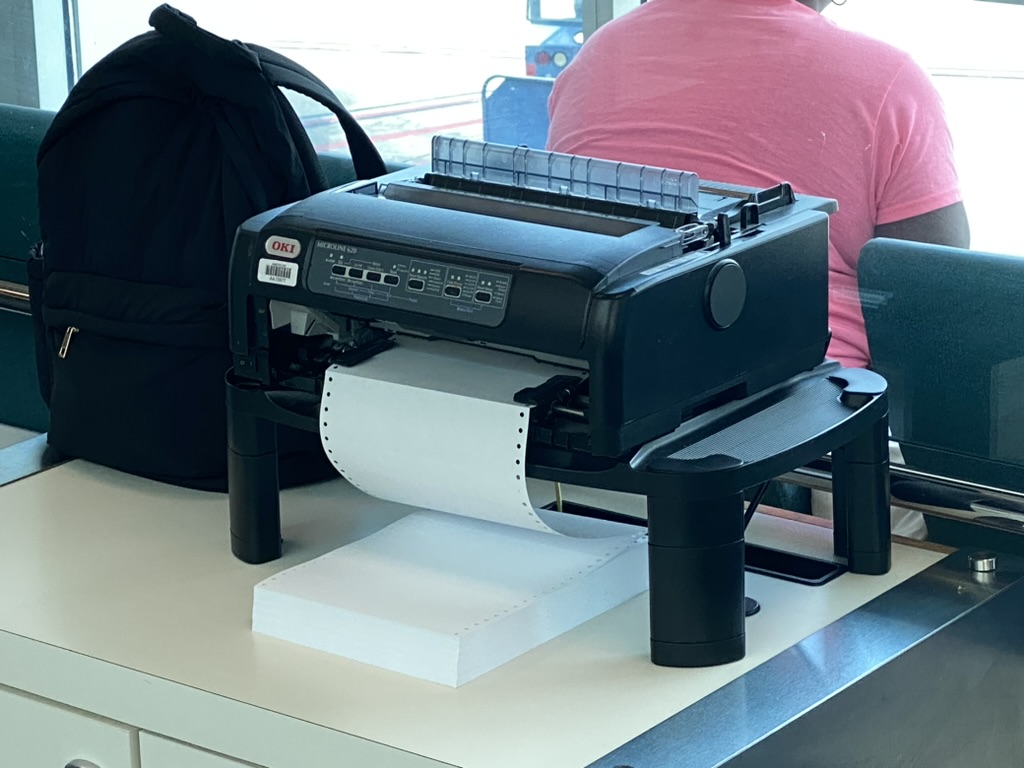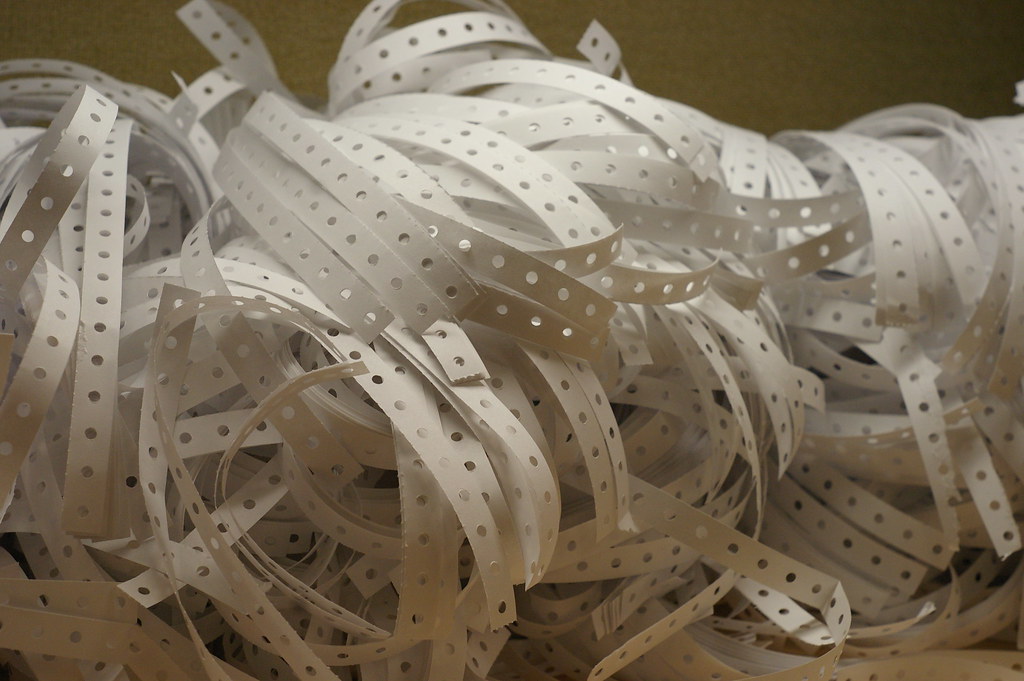If you’ve ever been sitting or standing near an airport gate before a flight, there’s a chance that you’ve heard a printer that’s spewing out seemingly infinite amounts of paper. I know there might be some of you reading this who have never seen one of these before. That device is a dot matrix printer. Way back before we all had laser printers, the majority of work was done with these ancient machines.
I thought they might be going away, but I just found one of these dinosaurs sitting on the counter at MCO.

Paper is fed by a tractor system, meaning the pages’ sides have perforated edges that align with spokes that keep the paper moving. After you’re done printing, you tear off these edges, leaving you with something looking like this.

The printing is done by a head that moves across the page from one side to the other. Using a series of “pins” and an ink ribbon, you slowly but surely get your printed document.
Well, unless the paper is misaligned and the sprockets miss the holes, but let us try to forget that if we can.
This technology is decades old, so why do they still use it at the airport?
I’ve found many instances of people asking this question online, but there doesn’t seem to be a single definitive answer.
Here are some of the most common explanations:
Technology
The reservation systems and other systems that run the airport are controlled by programs written for mainframe computers. These programs are written in computer languages that haven’t been used for decades, back when no one had even heard of a laser printer, USB, WiFi or “the cloud.” To make these legacy systems talk to laser printers would be amazingly challenging and labor-intensive.
I even read that in outstations, the data is relayed from the airline to the gate via a 9600 baud phone modem because there are no cable or satellite connections to get information there any other way. I have no way to confirm this, but if it’s true, DAMN!
Cost
Dot matrix printers are cheaper to operate than laser printers. Ink ribbons are much less expensive than toner cartridges. They break down less frequently, so they require fewer maintenance calls.
Going back to the first point, these printers are already installed. They work for what they need to do, and replacing them would be an investment in hardware (new printers), programmers (to write the new code so they’ll work with the old systems), and labor (installation and maintenance).
Why spend all of that money to fix a problem that doesn’t exist? However, many have pointed out that dot-matrix printers are more expensive to purchase today than laser printers. The model in the picture above is listed on Amazon for $800.
Functionality & Dependability
Dot-matrix printers are reliable. Even when they break, it’s not catastrophic. Paper doesn’t get stuck, requiring you to take the printer apart, like with a laser printer. When ink runs out on the ribbon, it’s a gradual process. You don’t have a printer that refuses to print because the counter on the cartridge has reached zero.
With a dot matrix printer, you have an (almost) endless paper length. Need to print five pages of a passenger manifest? No problem. There’s also no need for staples to keep those pages together as dot matrix paper isn’t fed by individual sheets.
Regulations
One of the more interesting points brought up was that airports use dot matrix printers for the same reason they still use them when you’re buying a car. Some documents need to be produced with multiple copies. Dot matrix printers can use “carbon” paper (read: triplicate paper), which will print several copies of a document.
If there’s a form that the plane’s captain has to sign for the local authorities, with one copy to be kept by the airline on the ground and one for the plane, a dot matrix printer can handle that task. Not so for a laser printer.
Until laws and regulations are changed worldwide, allowing digital documentation, this seems to make the most sense of why dot matrix printers exist.
Final Thoughts
I do feel a bit nostalgic when I hear those printers at the airport. I spent hours at home printing out baseball stats and bowling score sheets (which were in triplicate). I also printed most of my school papers on a dot matrix until laser printers became more affordable.
I also remember that when I started my “real” job, I had to work with one of those printers running almost non-stop in my ear all day long. All the while, I was expected to work and be friendly to customers. I don’t miss trying to talk on the phone when one of those printers was running at full speed.
When it comes to the reason why dot matrix printers are still in use at airports, I will bet it’s a combination of all of the reasons mentioned above. They work, they’re affordable, replacing them would be expensive, and they might even be necessary under current laws.
I wouldn’t expect that buzzing sound from these printers to disappear from the airports any time soon.
Want to comment on this post? Great! Read this first to help ensure it gets approved.
Want to sponsor a post, write something for Your Mileage May Vary or put ads on our site? Click here for more info.
Like this post? Please share it! We have plenty more just like it and would love it if you decided to hang around and sign up to get emailed notifications of when we post.
Whether you’ve read our articles before or this is the first time you’re stopping by, we’re really glad you’re here and hope you come back to visit again!
This post first appeared on Your Mileage May Vary

15 comments
[…] Explanations for why airlines still use dot matrix printers at airports […]
For carbon copies??
Yeah, there was a time when things were simply toss aside and replaced with the latest and greatest fad item unless there was a real ROI in doing so. These days it’s 3 year life span at most then out, unless it’s smart phones then it’s every year……..
While yes we can use the carbon paper option for these, no one does. If we need a signed copy of a release there are just two copies printed and we sign one then keep the other. One big reason we keep them, because of the no staple thing. All the paper is kept in one continuous loop and it’s easier to find what we’re looking for. Nothing gets lots.
The big big reason why??? Because everyone is slowly moving to digital releases and soon we won’t print anything. No need to upgrade systems that will no longer be needed in a few years.
ACARS communications from plane to ground operate at 2400 baud.
Noise from a dot matrix printer is nothing compared to the old Teletype machines of yore!
Still, agree with the ‘if it ain’t broke, don’t fix it ‘ concept. Ca
This brought back memories. Many decades back the company I then worked for was on dot matrix printers, With a good amount of effort and experimentation I was able to convert over to laser. It was a new thing then. If I could handle the coding and printer driver work I would think they would be able to do the same.
In our case using dot matrix required expensive pre-printed forms (for the appearance of customer invoices, etc.), rather than plain paper. With the laser printer printing all the form acceptably on plain paper Because of that the project quickly paid for itself. If it had been just plain green-bar or the like it would have been way less savings (if any).
I do agree dot matrix reports for reports were easier to leaf through and you didn’t have to worry about getting pages out of order.
They use carbonless duplicate or triplicate paper. And dot matrix printer today are much more expensive than laser printer.
The real answer is airlines bought a 39 year supply of tractor feed paper! Once it’s depleted other options will be considered.
We use this to print the flight release. The captain has a digital copy but the FAA still requires a hard copy. We also print out an updated weather report which the captain also has a digital copy of.
As a standby passenger…. When you hear that sounds of the dot matrix printer… there’s a good chance you didn’t make that flight. Haha
NOPE, I’m an airline pilot and those printers are kept for my 50′ of paperwork that need to be printed on a continuous sheet because I need to separate it at about 4 places each flight and where it separates changes. If it were done by standard 8 1/2 by 11 sheets then where I would rip the paper might be resulting me in several slivers of full sheets. This ensures tidiness, consistency, standardization, and precision with where I’m having to separate.
Having worked for an airline, it is just attrition. When it wears out, it gets replaced. In some instances, the continuous form is beneficial, but overall 8.5×11 is just fine. I want to know why airlines are still using thermal paper? Boarding passes do not need to have a shelf life, but tickets printed on that thermal paper stock do fade. Even worse leave one in a hot car, and watch the ticket turn totally black.
Thermal printing it’s the faster way to print in smaller 2 or 3 inches format. Sure, boarding passes are getting replaced by digital/phone passes, but bag tags include and RFID anthena to track where your bag is at all times. So that’s not going away anytime soon.
8.5×11 won’t do it because regulation ask for the manifest to be printed on a single continuos page.
Regards.
If your office was real fancy, it actually had an attachment that would pull off the two stripes on either side away … and also now, in a strange way, it’s hard to fake … anyone can hand you a laser print out that looks authentic but a printout on a dot matrix printer? No way to fake that without A LOT of work and planning. BTW, Epson still sells several different versions in case you want one …